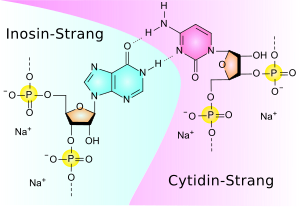Poly I:C
Poly I:C ist ein Polymer und Analogon von doppelsträngiger RNA.
| Strukturformel | |||||||||
|---|---|---|---|---|---|---|---|---|---|

| |||||||||
| Allgemeines | |||||||||
| Name | Poly I:C | ||||||||
| Andere Namen |
| ||||||||
| CAS-Nummer | 24939-03-5 | ||||||||
| PubChem | 32744 | ||||||||
| ATC-Code | |||||||||
| Eigenschaften | |||||||||
| Aggregatzustand |
fest | ||||||||
| Sicherheitshinweise | |||||||||
| |||||||||
| Toxikologische Daten | |||||||||
| Soweit möglich und gebräuchlich, werden SI-Einheiten verwendet. Wenn nicht anders vermerkt, gelten die angegebenen Daten bei Standardbedingungen. | |||||||||
Eigenschaften Bearbeiten
Poly I:C besteht aus zwei polymeren Strängen von Längen zwischen 1,5 und 8 kb,[3] einem Poly-Inosinsäure- und einem Poly-Cytidinsäure-Strang, die über Wasserstoffbrückenbindungen aneinander binden und einen Doppelstrang bilden. Poly I:C bindet in Tieren an den Toll-like Receptor 3 (TLR-3) und aktiviert ihn, wodurch in Folge die angeborene Immunantwort aktiviert wird.[4] TLR-3 wird von B-Zellen, Makrophagen und dendritischen Zellen gebildet. Der ATC-Code von Poly I:C ist L03AX07.[5] In Folge der Aktivierung des TLR-3 durch Poly I:C werden Interferone des Typs I gebildet.[6]
Außer an TLR-3 bindet Poly I:C, abhängig von seiner Länge,[7] auch an RIG-I und MDA5.[8][9][10] Poly I:C aktiviert die Proteinkinase R.
Poly I:C wird als Adjuvans bei Impfstoffen[11][12] und zur Induktion einer Apoptose in Krebszellen untersucht.[13] Ein alternativer Agonist des TLR-3 ist RGC100, ein Poly-Guanylsäure:Poly-Cytidinsäure-Doppelstrang mit geringerer Toxizität und ungefähr 100 Basenpaaren Länge, da von TLR-3 nur die wiederholenden Ribose-Einheiten sequenzunabhängig gebunden werden und eine Aktivierung bereits ab etwa 45 Basenpaaren erfolgt.[14]
Einzelnachweise Bearbeiten
- ↑ Datenblatt Polyinosinic–polycytidylic acid potassium salt bei Sigma-Aldrich, abgerufen am 15. Juli 2020 (PDF).
- ↑ a b A. A. Smorodintsev, O. A. Aksenov, I. K. Konstantinova, L. M. Vil'ner, A. V. Tinufanov: [Comparative study of the toxicity of poly G-poly C and poly I-poly C in different objects]. In: Voprosy virusologii. Nummer 2, 1978 Mar-Apr, S. 201–206, PMID 664621.
- ↑ H. Kato, O. Takeuchi, E. Mikamo-Satoh, R. Hirai, T. Kawai, K. Matsushita, A. Hiiragi, T. S. Dermody, T. Fujita, S. Akira: Length-dependent recognition of double-stranded ribonucleic acids by retinoic acid-inducible gene-I and melanoma differentiation-associated gene 5. In: The Journal of Experimental Medicine. Band 205, Nummer 7, Juli 2008, S. 1601–1610, doi:10.1084/jem.20080091, PMID 18591409, PMC 2442638 (freier Volltext).
- ↑ Y. Li, X. L. Xu, D. Zhao, L. N. Pan, C. W. Huang, L. J. Guo, Q. Lu, J. Wang: TLR3 ligand Poly IC Attenuates Reactive Astrogliosis and Improves Recovery of Rats after Focal Cerebral Ischemia. In: CNS Neuroscience & Therapeutics. Band 21, Nummer 11, November 2015, S. 905–913, doi:10.1111/cns.12469, PMID 26494128, PMC 4638223 (freier Volltext).
- ↑ WHO: L03AX07
- ↑ I. Yoshida, M. Azuma: An alternative receptor to poly I:C on cell surfaces for interferon induction. In: Microbiology and Immunology. Band 57, Nummer 5, Mai 2013, S. 329–333, doi:10.1111/1348-0421.12050, PMID 23668603.
- ↑ H. Kato, O. Takeuchi, E. Mikamo-Satoh, R. Hirai, T. Kawai, K. Matsushita, A. Hiiragi, T. S. Dermody, T. Fujita, S. Akira: Length-dependent recognition of double-stranded ribonucleic acids by retinoic acid-inducible gene-I and melanoma differentiation-associated gene 5. In: The Journal of Experimental Medicine. Band 205, Nummer 7, Juli 2008, S. 1601–1610, doi:10.1084/jem.20080091, PMID 18591409, PMC 2442638 (freier Volltext).
- ↑ N. Dauletbaev, M. Cammisano, K. Herscovitch, L. C. Lands: Stimulation of the RIG-I/MAVS Pathway by Polyinosinic:Polycytidylic Acid Upregulates IFN-β in Airway Epithelial Cells with Minimal Costimulation of IL-8. In: Journal of immunology. Band 195, Nummer 6, September 2015, S. 2829–2841, doi:10.4049/jimmunol.1400840, PMID 26283481.
- ↑ Y. S. Cheng, F. Xu: Anticancer function of polyinosinic-polycytidylic acid. In: Cancer biology & therapy. Band 10, Nummer 12, Dezember 2010, S. 1219–1223, doi:10.4161/cbt.10.12.13450, PMID 20930504 (Review).
- ↑ S. Palchetti, D. Starace, P. De Cesaris, A. Filippini, E. Ziparo, A. Riccioli: Transfected poly(I:C) activates different dsRNA receptors, leading to apoptosis or immunoadjuvant response in androgen-independent prostate cancer cells. In: Journal of Biological Chemistry. Band 290, Nummer 9, Februar 2015, S. 5470–5483, doi:10.1074/jbc.M114.601625, PMID 25568326, PMC 4342463 (freier Volltext).
- ↑ K. A. Martins, S. Bavari, A. M. Salazar: Vaccine adjuvant uses of poly-IC and derivatives. In: Expert Review of Vaccines. Band 14, Nummer 3, März 2015, S. 447–459, doi:10.1586/14760584.2015.966085, PMID 25308798.
- ↑ G. G. Guerrero Manriquez, I. Tuero: Adjuvants: friends in vaccine formulations against infectious diseases. In: Human vaccines & immunotherapeutics. Band 17, Nummer 10, Oktober 2021, S. 3539–3550, doi:10.1080/21645515.2021.1934354, PMID 34288795, PMC 8437479 (freier Volltext) (Review).
- ↑ F. Bianchi, S. Pretto, E. Tagliabue, A. Balsari, L. Sfondrini: Exploiting poly(I:C) to induce cancer cell apoptosis. In: Cancer Biology & Therapy. Band 18, Nummer 10, Oktober 2017, S. 747–756, doi:10.1080/15384047.2017.1373220, PMID 28881163, PMC 5678690 (freier Volltext).
- ↑ K. Naumann, R. Wehner, A. Schwarze, C. Petzold, M. Schmitz, J. Rohayem: Activation of dendritic cells by the novel Toll-like receptor 3 agonist RGC100. In: Clinical & Developmental Immunology. Band 2013, 2013, S. 283649, doi:10.1155/2013/283649, PMID 24454470, PMC 3878805 (freier Volltext).